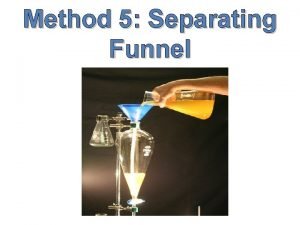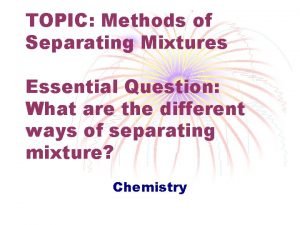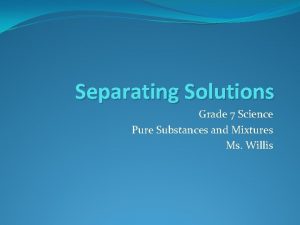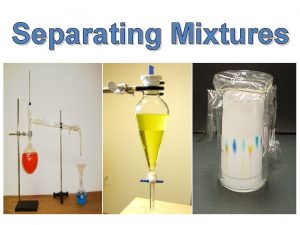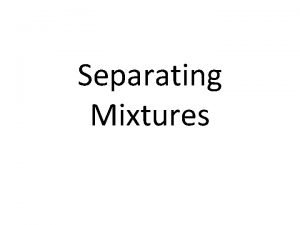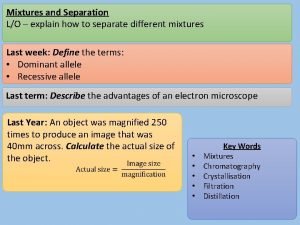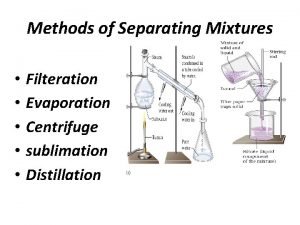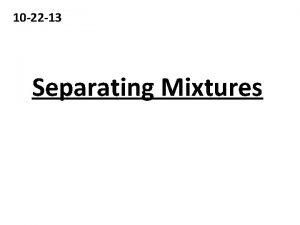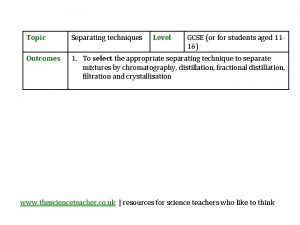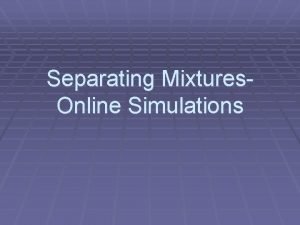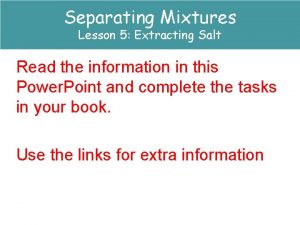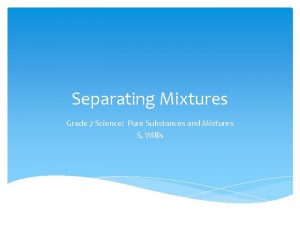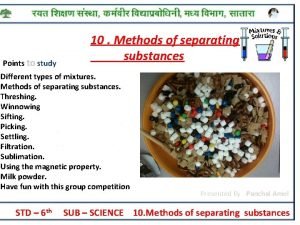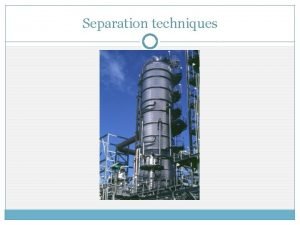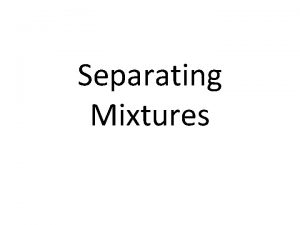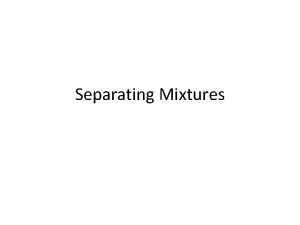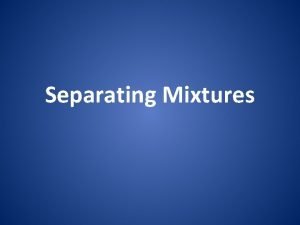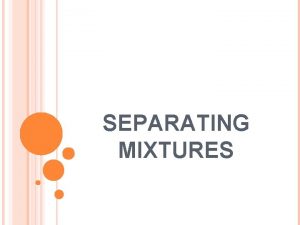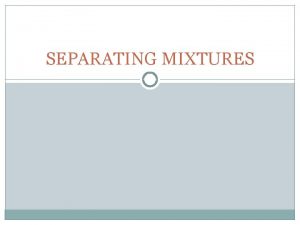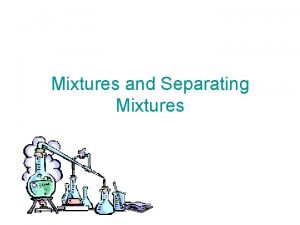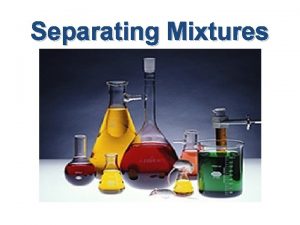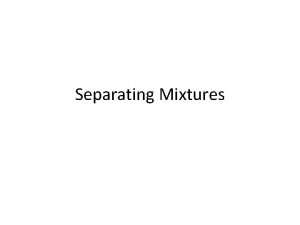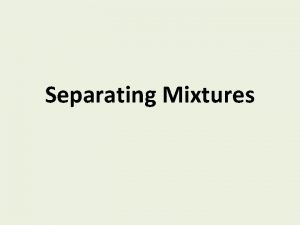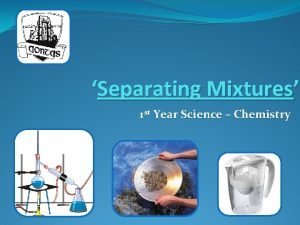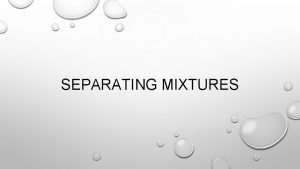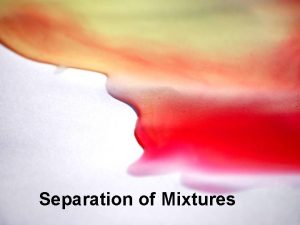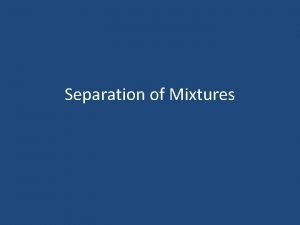Separating Mixtures Aim I can use different processes
















- Slides: 16

Separating Mixtures

Aim • I can use different processes to separate mixtures of materials. Success Criteria • I can identify different ways materials can be mixed together. • I can use sieving, filtering, evaporating and other processes to separate mixtures of materials. • I know when to use which processes to separate mixtures.

Supermarket Chaos! A local supermarket has had a disaster! Lots of their goods have got mixed up after a delivery truck was loaded up incorrectly. The manager of the supermarket has asked for your help in separating all the items so that they can be put on the shelves. Have a look at the jumbled up materials and think about how they have been mixed together.

Mixed Materials – Sand Water Several water bottles have leaked into a bag of play sand.

Mixed Materials – Salt and Water A bag of salt has split open and the salt has mixed with some water from the water bottles.

Mixed Materials – Raisins and Flour Raisins have poured out of their boxes into the bags of flour.

Mixed Materials – Paper clips and Rice Some boxes of paper clips have spilled into the bags of rice.

Mixed Materials 1. A suspension - a mixture of a liquid and solid particles that will not dissolve. A. Sand water. 2. A mixture of two solids. 3. A solution a solid dissolved in a liquid. 4. A mixture of two solids. B. Raisins and flour. C. Paper clips and rice. D. Salt and water.

Mixed Materials How did you do? 1. A suspension - a mixture of a liquid and solid particles that will not dissolve. 2. A mixture of two solids. 3. A solution - a solid dissolved in a liquid. 4. A mixture of two solids. A. Sand water. B. Raisins and flour. D. Salt and water. C. Paper clips and rice.

Mixed Materials Since each of these mixtures of materials has been mixed differently, you will need to use different processes to separate them. Talk to your partner about ways you could separate them. 1. A suspension - a 3. A solution - a mixture of a 2. A mixture of 4. A mixture of solid dissolved liquid and solid two solids. in a liquid. particles that will not dissolve. A. Sand B. Raisins and D. Salt and C. Paper clips water. flour. water. and rice.

Separating Processes Evaporation Boil the mixture, or leave it for a few days, so the liquid evaporates leaving the solid behind. How? This process is best used to separate the salt and water solution. As the salt has dissolved in the water, filtering would not separate the two materials. The salt particles would go through the filter paper along with the water. When the salt water solution is evaporated, the water will turn into water vapour and leave the salt behind.

Separating Processes – Magnetic Attraction How? Use a magnet to attract any magnetic materials and remove them from the mixture. Use this process to separate the paper clips from the rice. The paper clips are made of steel and will be attracted to the magnet. The rice is not magnetic so will stay in the bowl.

Separating Processes - Filtration Line a funnel with filter paper and place it over a beaker. Pour the mixture slowly into the filter paper. The liquid will get through and any insoluble solids will be caught in the filter paper. This process should be used to separate the mixture of sand water. Sand is insoluble, so it has not dissolved in the water. The sand particles will not be able to get through the tiny holes in the filter paper, but the water particles will. The sand will be caught in the filter paper while the water will get through to the bowl. How?

Separating Processes - Sieving Pour the mixture through a sieve held over a bowl. The smaller particles will get through it into the bowl and the larger particles will be caught in the sieve. How? Use this process to separate the mixture of raisins and flour. The grains of flour are much smaller than the raisins, so they will be able to go through the sieve into the bowl below. The raisins are much bigger, and will get caught in the sieve.

A Message from the Manager Thank you for separating the mixed up materials! Unfortunately, we found one more mixture in the delivery truck. Some of the sand some of the salt have both mixed with a spilt bottle of water. How can we separate both the sand the salt from the water?

 A separating funnel is used to separate
A separating funnel is used to separate Centrifuge separating mixtures
Centrifuge separating mixtures Distillation grade 7
Distillation grade 7 Filtration examples in everyday life
Filtration examples in everyday life Evaporation mixture example
Evaporation mixture example Magnetism separating mixtures examples
Magnetism separating mixtures examples Natural science grade 7 lesson plans term 2
Natural science grade 7 lesson plans term 2 Chromatography separating mixtures
Chromatography separating mixtures Sublimation
Sublimation 10 methods of separating mixtures
10 methods of separating mixtures Separation techniques gcse
Separation techniques gcse Separating mixtures fossweb
Separating mixtures fossweb Miscible and immiscible liquids worksheet
Miscible and immiscible liquids worksheet How to separate mechanical mixtures
How to separate mechanical mixtures Sublimation process of separating mixtures
Sublimation process of separating mixtures Objectives in separating mixtures
Objectives in separating mixtures Example of magnetism in separating mixtures
Example of magnetism in separating mixtures
